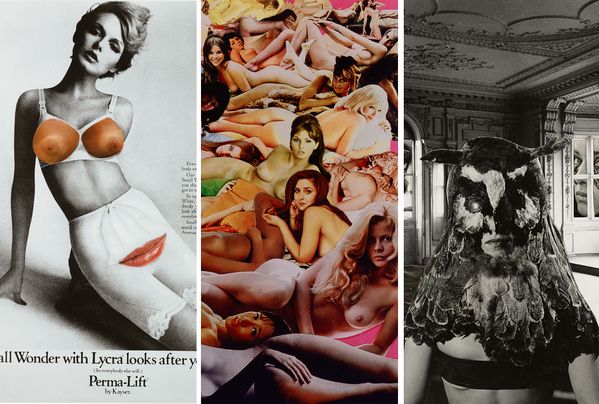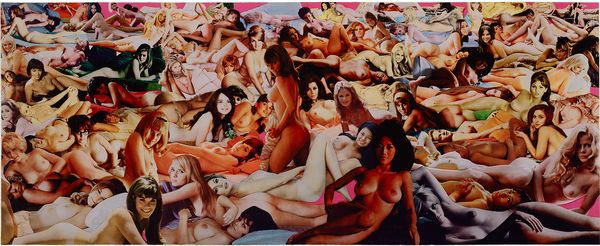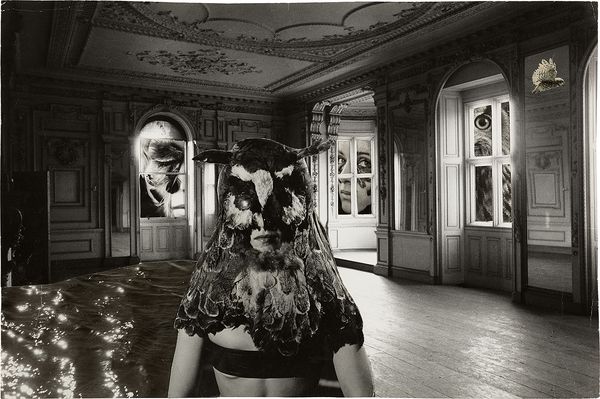Details of works by Martha Rosler (Left and Center) and Penny Slinger (Right). 20th Century & Contemporary Art: Online Auction, New York.
In the hands of pioneering artists Martha Rosler and Penny Slinger, photomontage and collage are inherently rebellious. Beginning in the 1960s, the artists each approached the medium with individual intent, appropriating or combining disparate visual elements to form images that are as exigent as they are provocative. These works helped spark a consideration of the power imbalance between the looker and the seen, specifically challenging the midcentury norms of how women are depicted and how their images are consumed.
Martha Rosler’s process brought together images of women taken from a variety of sources, including magazine advertisements and the pages of Playboy. “I wanted to use images of women from mass magazines, virtually all of which were engaged in shameless stereotyping,” she later explained, going on to note that she wanted her work to be seen as what would later be understood as “a deconstruction of the image.” For Penny Slinger, who faced criticism at the time for powerfully erotic depictions of herself, the act of making collage was empowering. She later explained that “In the process of sorting and distilling the archetypes, I felt myself emerging from a nightmare of others’ projections.”
Below, we explore examples of these two artists’ defining practices in the 1960s and 1970s that are on offer in the upcoming 20th Century & Contemporary Art: Online Auction at Phillips New York, open for bidding from 7–14 December.
Martha Rosler
Martha Rosler, Hothouse, or Harem from the series Body Beautiful, or Beauty Knows No Pain, 1966–1972. 20th Century & Contemporary Art: Online Auction, New York.
The images of women in Martha Rosler’s Hothouse, or Harem are snipped exclusively from Playboy. To source the images, the artist pulled discarded issues of the magazine from communal trash cans in her New York apartment building and from public dumps in Southern California. This process alone reflects the imagery’s status as a disposable pleasure, intentionally published to hold the attention of men only until the next month’s issue arrived. By stripping these images from their original context (each model was originally featured alone and in varying aspirational settings — none are centerfolds), the subjects figuratively band together and refuse to exist solely in the realm of male fantasy. They also refuse to be discarded.
Rosler takes advantage of the fact that printing quality varied widely at the time, resulting in a variety of skin tones on the mostly white models. This mixture of tone, coupled with the colorful accents of the soft blankets and pillows the models coyly use to partially cover themselves, adds an ecstatic sense of color to the image, which seems to have an almost endless depth. Further, by placing Asian models in the foreground, Rosler implies a link between militaristic subjugation and submissive fetishism as the war in Vietnam raged on.
Rosler’s Playmates have been asked to provide “Entertainment for Men” one too many times. In response, they overproduce female submission to the point where it becomes something like its opposite — a wave of naked defiance.
—Richard Meyer
This work was used as the cover sleeve for the book accompanying the 2007 exhibition WACK! Art and the Feminist Revolution at the Museum of Contemporary Art in Los Angeles — the first major institutional retrospective of feminist art. The use of the work as the cover sparked fierce debate. Arguments ranged widely on the online message board accompanying the exhibition, from confusion to downright attacks. Criticism included suggestions that imagery of young, thin women perpetuate beauty standards that feminism has actively sought to displace. Others argued that even if the imagery is misunderstood, perhaps it is a good thing for (presumably male) viewers to be seduced to discover more about feminist art. Ultimately, Lisa Gabrielle Mark, the director of publications at the museum, wrote, “After looking at over thirty possible covers, we opted for something we expected would provoke discussion on issues fundamental to feminism, and clearly this cover has.”
Sources of Rage
Martha Rosler, Small Wonder from the series Body Beautiful, or Beauty Knows No Pain, 1966–1972. 20th Century & Contemporary Art: Online Auction, New York.
For both Martha Rosler and Penny Slinger, many of their ideas were born in reaction to how women were portrayed in media geared towards men. Yet also noteworthy is the way women were portrayed in women’s magazines of the time. In a 2018 VICE article that surveys such magazines from the ‘50s, ‘60s, and ‘70s, writer Caroline Thompson uncovers “how women were told to be women.” Highlights include tips for ensuring your teenage daughter is marriage material (she can apparently be neither too prude nor too promiscuous), ladylike smoking etiquette (don’t smoke on the street or in elevators and never bum cigarettes from men), hygiene tips (douche frequently), and marriage advice (in brief, any marital problems are the women’s fault and can be solved by getting pregnant).
These kinds of media were reclaimed in Martha Rosler’s collage works from the era to expose the malevolence of their content. The above work from 1966–1972, Small Wonder, is characteristic of her practice at the time, which often combined commercial imagery with cutouts of nude female body parts. Her deceptively simple intervention on the image critiques its underlying message, as she later noted, “We cannot always decipher ideological messages that lurk behind attempts to sell us either clothes or political ideas.”
Penny Slinger’s works from the time also explore a powerful tension. They at once express a critique of the pervasive subjugation of women and celebrate feminine sexual liberation. This tension didn’t easily align with the political and social emphasis of mid-‘70s feminism. It was also deeply misconstrued by the male-dominated art world. As Slinger recalled of her first major exhibition in New York, “Unfortunately, many of the people who came to the exhibition were rich and powerful men, three in particular who could have bought most of the exhibition but ended up not buying anything because I wouldn’t sleep with them, and I was frankly totally disgusted by this.” It was shortly after this experience that Slinger abandoned the mainstream art ecosystem. She relocated to a remote island in the Caribbean, where she would live and work for 15 years.
Penny Slinger
Penny Slinger, Our Lady of the Owls from the series An Exorcism, 1970–1977. 20th Century & Contemporary Art: Online Auction, New York.
Slinger’s collage works from the 1970s explore Surrealism, sexual liberation, and reflections on the psychological and mythological from a feminist lens. Her work often employed herself as subject to reclaim the image of the female body through a dark sexuality. She has reflected that the intention of the work is not just to expose the body parts that make up how a woman appears, but how “I’m also trying to show something about how a woman is inside, and therefore not showing just a surface but showing these other elements in relation to it to jog us into the subconscious and the unconscious and the world of fantasies.”
The above work is from the series An Exorcism, a set of collage works that evolved over more than seven years. The series is rooted in the discovery of a run-down country home in Northamptonshire, where the artist began a psychodrama film project intended to explore the metaphysics of the unconscious. The film was ultimately never produced, but Slinger’s photographs of the eerie empty rooms continued to speak to her. Following the artist’s work on the film The Other Side of the Underneath, the demands of which led to a personal crisis, she began to work on the series as a way to piece her psyche back together.
The haunting and evocative images are inundated with visual elements of country homes, flowers, birds, judges, and nude flesh that seem to reflect a terrifying and distinctly British subconscious. She has said of the series, “It is my hope that the ‘Exorcism’ series will help shed some light on areas of the Western psyche which have remained too long hidden in the darkness.” It was shortly after the completion of this series that Slinger disengaged from the art world and relocated to the Caribbean.
Having recently returned to the system of mainstream galleries and institutions, Slinger has met with widespread success. She was included in the exhibitions Angeles of Anarchy: Women Artists and Surrealism (2012) at Manchester Art Gallery and The Dark Monarch (2014) at Tate St. Ives. Her works from the ‘70s have been revisited in solo exhibitions at galleries worldwide. Maria Grazia Chiuri commissioned the artist to create the scenography for Dior’s Autumn / Winter 2019 Haute Couture show and that collection’s final look was inspired by Slinger’s Doll Houses series. Richard Kovitch’s recently-released documentary Penny Slinger — Out of the Shadows unpacks the artist’s life, telling the formative story leading up to the series An Exorcism, in addition to her departure from and return to the art world.
Discover More from 20th Century & Contemporary Art: Online Auction, New York >
Recommended Reading



